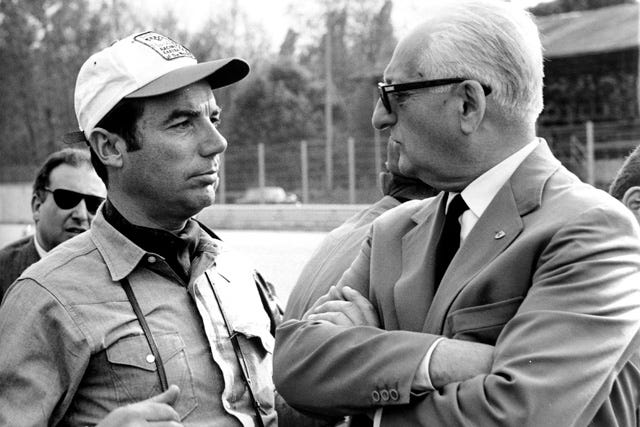Ferrari in the 1950s
Curated Mid-Century Modern Home Listings 📍
As of this writing, Ferrari is a $84B publicly-traded company (NYSE: RACE) synonymous (for many) with performance and prestige. But Ferrari’s fortunes weren’t always so. Today, we’ll take a look at a pivotal era for Ferrari, where the fledgling Maranello-based motorsports shop laid a foundation for future automotive eminence.
Emerging from the aftermath of World War II, Enzo Anselmo Ferrari, the company's founder, embarked on a mission to create high-performance sports cars that would dominate the racing circuit. A former salesmen and racing driver for Alfa Romeo, Enzo was passionate about motorsports, not consumer cars.
Enzo was managing a complicated end to his relationship with Alfa that would soon develop into a bitter rivalry. During the war years, the Ferrari factory (then called Auto Avio due to the arrangement with Alfa) was moved from Modena to Maranello in hopes of avoiding allied bombing. Nevertheless, the factory was hit by bombs twice in 1944. The factory was re-built and used for war production under Mussolini’s fascist regime. Coming out of the wartime, Ferrari S.p.A. was formalized in 1947.
From there, things really started to speed up as Ferrari got back to its pursuit of racing championships. Having won its first Mille Miglia in 1948, its first Le Mans 24 Hour Race in 1949 and its first Formula 1 World Championship Grand Prix in 1951, Ferrari became official World Champions for first time in 1952 thanks to Alberto Ascari who repeated his feat the following year. The decade would go on to include countless other motorsports triumphs.
It was both Ferrari's dominance in sports car racing and financial pressures that galvanized a push into road car production. The company's iconic V-12 250 GT was first introduced in 1952. The versatile and powerful sports car, achieved remarkable success in endurance races like the Mille Miglia and the 24 Hours of Le Mans. Its obvious why the 250 GT's with its combination of speed and elegance would be coveted by wealthy enthusiasts and collectors. Ferrari produced some 1,317 road cars and 231 competition cars in the 250 GT series, representing a financial boon for the company. Today, 250 GTs and all their more exclusive variants are among the most collectible and valuable physical artifacts, more akin to fine art than used cars.
The 1950’s were not without challenge and heartbreak for Enzo and co.. Ferrari faced intense competition from rival manufacturers, most notably Alfa Romeo and Mercedes-Benz. The loss of talented drivers, such as Alberto Ascari and Piero Taruffi, to horrific accidents also cast a shadow over the company's success. Enzo’s beloved son, Alfredo, or Dino as he was better known, died of muscular dystrophy in 1956. Ferrari had tried to involve him in the design of a new 1500 cc V6 until the very end of his life. The engine finally debuted 10 months after Dino’s death. That car design and a series of Ferrari V6 engines are named in his honor. All these setbacks, while painful, served as a catalyst for Ferrari to redouble its efforts and strive for even more ambitious achievements.
Despite the challenges, Ferrari's legacy was firmly established by the end of the 1950s. The company's iconic designs, race performance, and leadership had captured the hearts of motorsports fans worldwide. The decade's achievements laid the foundation for Ferrari's continued dominance in the world of motorsport and luxury automobiles. Will the company fare as well in 2020s and beyond? Well, it’s been 16 years since Ferrari’s last F1 championship but retail sales continue to climb. So, we’ll wait and see.
If you want to dive deeper into Ferrari history, check out Enzo Ferrari: The Man and the Machine.
“No one remembers who took second place and that will never be me.”
Enzo Ferrari
GEMS FOR SALE THIS WEEK
9361 Farralone Ave, Chatsworth, CA 91311
7221 SE Madison St, Portland, OR 97215
658 Poplar Street, Denver, CO 80220
Support Mid-Century Mondays by becoming a Paid Subscriber:
Keep reading with a 7-day free trial
Subscribe to Mid-Century Mondays to keep reading this post and get 7 days of free access to the full post archives.








